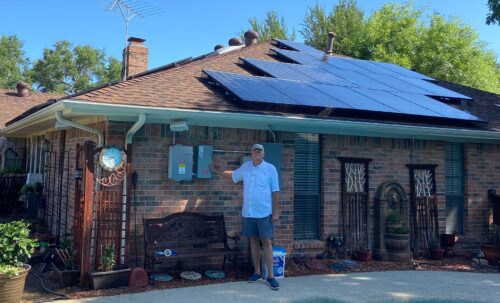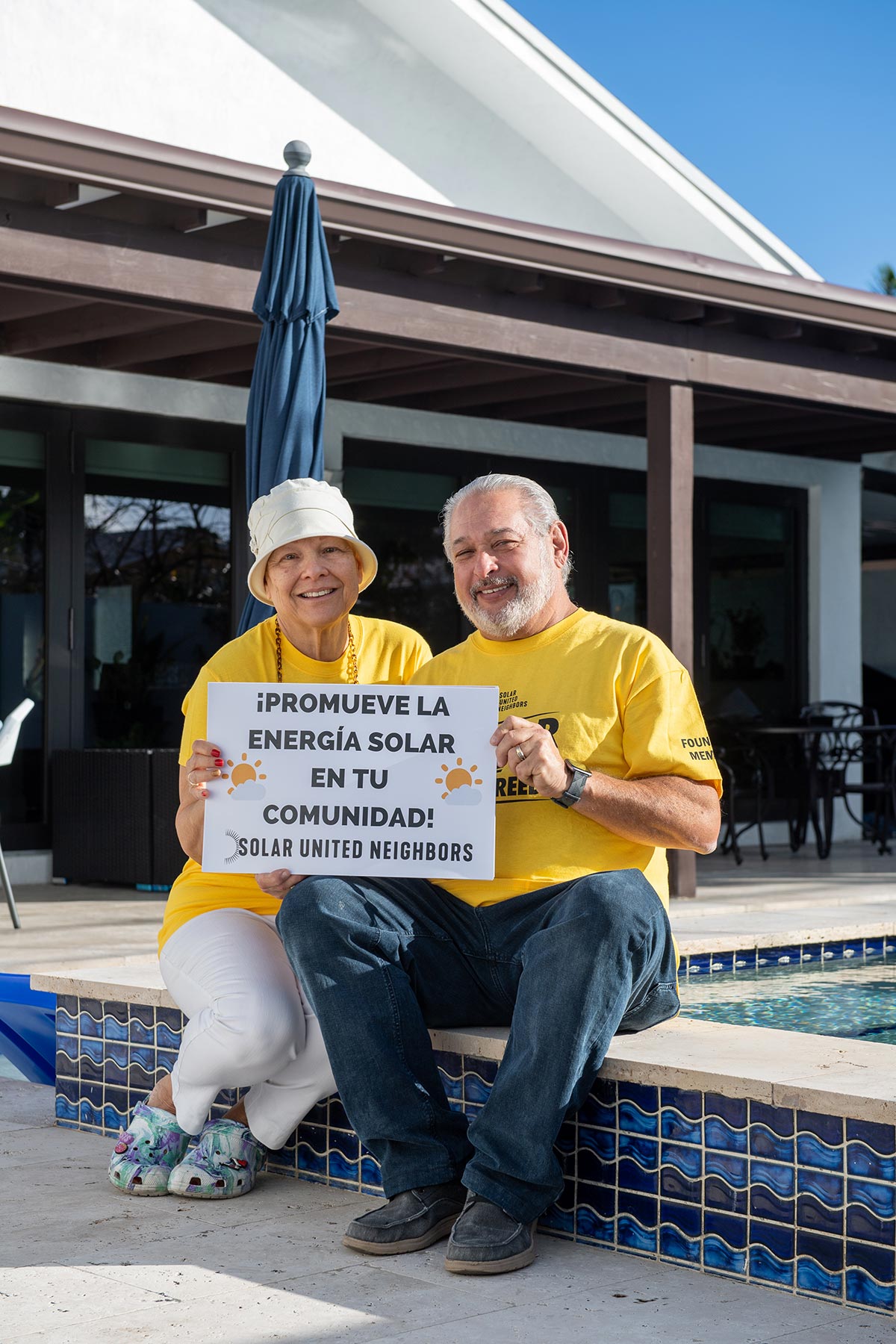Photo courtesy Sun United Neighbors

Bringing Solar Power to the People
By addressing equity issues, RMI’s Solarize cohorts have made rooftop solar and lower electricity bills available to more people around the country.
Shaketia Simpson loved the idea of powering her house with solar energy, but always thought of it as a future project because it was too expensive. Simpson, an operating director at Discovery Montessori School and single mother with two teenage kids living in Asheville, North Carolina, has a house that she built with the help of Habitat for Humanity.
“Habitat called me up and asked if I was interested in solar, and I said, ‘Yes, I’ve actually been looking to get solar but I didn’t think I’d be able to afford it.’” However, through a local Solarize campaign, she qualified for a grant program, and now she has a 4 kilowatt (kW), 10-panel solar system adorning the roof of her home.
Solarize campaigns help people access rooftop solar systems by lowering equipment costs through bulk purchases and streamlining the sometimes complicated permitting and construction process. Even so, the upfront cost of solar can still be prohibitive to many. That’s why RMI decided to work with cities across the United States to launch inclusive Solarize campaigns. In 2021 and 2022, RMI organized cohorts that included 27 cities from Boston to Honolulu to support them in implementing Solarize campaigns targeted to low- and moderate-income (LMI) communities.
“Historically, Solarize campaigns have not been very equitable, and what our work with cities was about was trying to address that,” said RMI Manager Ryan Shea. “Our Solarize cohort tried to help cities address this by integrating the LMI funding and community partnerships needed for more equitable campaigns.”
Improving the Economics
In many cases, a bulk purchasing discount alone isn’t enough to substantially decrease the initial cost of solar installation. That’s why RMI focused its city cohort workshops and support on reducing cost barriers for LMI communities even more through grants, funding, and other financing options. For example, Solarize Asheville-Buncombe dedicated over $100,000 in local government funds to fully fund lower-income installations, which is how Simpson was able to receive her solar system.

Shaketia Simpson excited about the solar panels being installed on her roof in Asheville, North Carolina. Photo courtesy Sugar Hollow Solar
“Because of the grant, I didn’t have to put any money down,” says Simpson of her new solar system. “And I saw my electricity bills go down right away.” Simpson has had her system since November 2022, and says that her electricity bills are down to less than $100 a month now. “Before I was paying over $250, and in the wintertime it would be close to $300,” she says. “I think in the summer months I might not have any electric bill at all.” With the money that she has saved, she was able to take her family on a spring break vacation to Florida.
Because of the grant, I didn’t have to put any money down. And I saw my electricity bills go down right away.
The Importance of Partnerships
RMI Senior Associate Jackie Lombardi says that reducing upfront costs are only one part of the challenge: “The most equitable campaigns tend to partner with both national Solarize experts and trusted frontline community-based organizations.”
That’s where RMI’s partners, Solar Crowdsource and Solar United Neighbors come in. Both organizations have been running Solarize campaigns for years. Don Moreland founded Solar Crowdsource in 2015 after working as a real estate attorney. He was always passionate about the environment, so after the 2008 recession, he started working on utility-scale solar projects.
Moreland saw a big need for residential and rooftop solar systems. “That’s really where my passion lies,” he said. “It’s a ‘power to the people’ kind of thing.” And one of his initial visions was to make solar more affordable and more accessible to all communities. “Equity has become an important part of all of our Solarize campaigns,” he explained.
Sophie Mullinax participated in the 2021 RMI cohort as part of her work running a clean energy program in Asheville. Through that cohort, she helped run the successful LMI campaign, along with local nonprofit Green Built Alliance, that Simpson participated in, where 12 households received solar systems. She is now a project manager for Solar Crowdsource, and has taken those lessons learned from Asheville to other communities. “The LMI component of that project spun off and continues to this day,” she said.
She is currently running an LMI Solarize campaign in Kansas City, Missouri, which was part of the 2022 cohort. “These will be 4 kW, 10-panel systems that will offset an estimated 50 percent of an LMI household’s electricity use,” she explained. All together Solar Crowdsource organized six campaigns with the RMI cohorts in Georgia, Hawaii, Missouri, North Carolina, and Oklahoma, helping more than 500 homeowners purchase solar systems.
Solar United Neighbors (SUN) started in 2007 when founder and current Executive Director Anya Schoolman’s teenage son Walter and his friend Diego wanted solar panels on their houses in Washington, D.C. Schoolman thought the project too expensive, and decided to see if a bulk purchase would make it more affordable. SUN’s first success came when Walter and Diego went door-to-door in the neighborhood, quickly signing up 50 homes interested in a solar system. Since then, SUN has spread across the country, and has helped over 7,800 homeowners go solar.
SUN calls their programs “solar co-ops,” and while similar to a traditional Solarize campaign, the solar co-ops have one main difference. “We are very much community based,” said Ben Delman, SUN’s senior director of communications. “So instead of picking an installer before getting the group together, the homeowners are actually the ones to review the bids and pick a local installer.”
SUN formed eight solar co-ops with the RMI cohorts, in Ohio, Florida, and Texas, helping 250 homeowners get solar systems. And Delman has seen the diversity of their co-ops grow over the years. “Tax credits help, as well as the declining costs of the technology,” he says. “But it also has to do with our community-based partners on the ground. We can provide solar expertise, but ultimately it’s the groups on the ground that have those relationships that make the co-ops run.”
We can provide solar expertise, but ultimately it’s the groups on the ground that have those relationships that make the co-ops run.

Vicky and Richard Delgado displaying their excitement for their new solar system in Hialeah, Florida. Photo courtesy Sun United Neighbors
Growing the Movement
Although SUN has helped almost 8,000 homeowners get solar on their roofs, Delman says that the impact goes well beyond that. “We really see that these solar co-ops are just one step in the chain of helping people go solar,” he explains. “We’re building this community of solar supporters, and then we’re working with that community to fight for solar rights and to make sure that the policies exist so that more people, regardless of their income level, can benefit from solar — whether that’s solar on their own homes or community solar or other avenues. So it’s really all part of the same model of building a clean energy system with rooftop solar at the cornerstone.”
Not all of the cities worked with a national partner. For the cities that ran their own campaigns, RMI developed a request for proposal template, communications templates, and worksheets to help them think through the process. And to help other local governments beyond the cohorts launch equity-focused Solarize campaigns in their own communities, RMI created a six-step guide with accompanying resources and templates to walk communities through running a Solarize campaign.
The campaigns organized through the RMI cohorts helped nearly 1,200 households install more than 10 megawatts (MW) of residential solar. These installations are estimated to save households over $8 million and avoid over 106,000 tons in CO2 emissions over their 25-year lifespan, equivalent to planting over 1.76 million trees. Overall, 40 percent of the households that purchased solar systems through the RMI Solarize cohort programs were in LMI or Black, Indigenous, and People of Color (BIPOC) communities.
Of course, rooftop solar systems aren’t practical for everyone, like renters or apartment dwellers. “To increase solar equity, Solarize is just one solution if done right, but there are many other solutions,” says RMI’s Shea. Moreland agrees, and says that his initial goal at Crowdsource was to take anybody who was interested in solar and put them where it made sense. “If you had a house, maybe you could get solar through a Solarize program. But if it wasn’t a good place for solar or if you were a renter, then we could put you into a community solar program,” he says. “But it was the Solarize programs that really took off,” he adds.
And Moreland is pleased with the work of Crowdsource and the RMI cohorts. “We’re proud to leverage what we have already been able to do, and continue to help people save money, stop burning fossil fuels, and live in healthier homes. We’re really hopeful for the future,” he explains.
Simpson couldn’t be happier with her system. “I’m glad that it’s saving energy and that I’m able to use natural resources to get that energy because I enjoy nature and the outdoors,” she says. “I’m glad they’re helping more people to become solar friendly here in the mountains.”
Top photo: Terry Morris with his newly installed solar system in Plano, Texas. Courtesy Sun United Neighbors